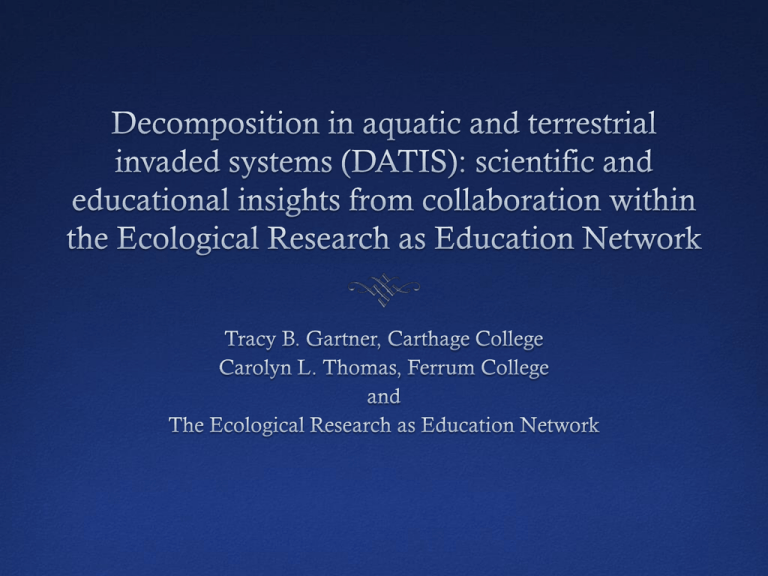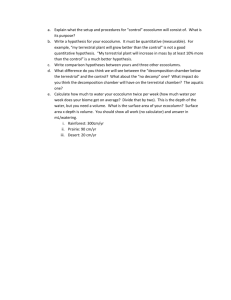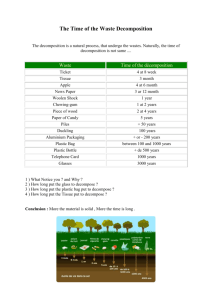Decomposition in Aquatic and Terrestrial Invaded Systems
advertisement

Scientific Background Woody invasive species influence many ecosystem functions [N] and decay rates often higher (Ehrenfeld 2010) Impacts may vary with species and relative abundance Methods vary between terrestrial and aquatic decomposition experiments Using the EREN Model Decomposition rates influenced by litter quality and site factors, which can vary with region U.S. Soil Nitrogen Concentrations from Hargrove and Luxmoore, 1998 EREN schools provide natural gradients and a mix of aquatic and terrestrial expertise Questions Are decomposition rates of invasive species faster than native species across a wide range of environments? Does increasing relative abundance of the invasive have a linear impact on decomposition rates? Can integrative protocols for aquatic and terrestrial decomposition studies be conducted successfully as part of an undergraduate curriculum? Participants Kevin Geedey - Augustana College, IL Rick Boyce – Northern Kentucky University, KY Jerald Dosch, Dan Hornbach – Macalester College, MN Kathy Shea – St. Olaf College, MN Fernando Nieto – SUNY College at Old Westbury, NY Rachel Schultz - SUNY Plattsburgh, NY Laurie Anderson – Ohio Wesleyan University, OH Craig Zimmerman – Rogers State University, OK Frank Kuserk – Moravian College, PA 10 sites in 2012-13 Jose-Luis Machado – Swarthmore College, PA Jamie March – Washington and Jefferson College, PA 18 sites in 2013-14 Kelly Lyons – Trinity University, TX Greg Eaton – Claytor Nature Study Center, Lynchburg College, VA Carolyn Thomas, Bob Pohlad - Ferrum College, VA Tracy Gartner - Carthage College, WI Carol Mankiewicz – Beloit College, WI Kim Bjorgo-Thorne – West Virginia University, WV Kevin Barry – West Virginia State University, WV Litterbag Experiment Leaves collected from locally relevant woody invasive and a morphologically & functionally similar native species Invasive Ex. Native Pairing Buckthorn Black Cherry, Gray Dogwood Honeysuckle Spice Bush Privet Texas Mountain Laurel Tree of Heaven Smooth Sumac Norway Maple Sugar Maple, Red Maple Honeysuckle Spicebush Buckthorn Tree of Heaven Dogwood Sumac Litterbag Construction Litterbags filled with varying ratios of two litter types (5 treatments x 5 reps/harvest) Native Invasive T1 T2 T3 T4 T5 • 20 cm2 custom nylon bags • Bottom: 1/16” mesh • Top: 1/4” mesh Deployment 2012-2013 Aquatic Environment • Invasive decomposition not always slower • May be species specific (Ailanthus vs. Rhamnus) Terrestrial Environment • Faster decay by Rhamnus • Ailanthus decay variable 2013-2014 Results Aquatic Decay Terrestrial Decay ? ? Assessment "The consistent interplay between curiosity and understanding in both teaching and research is what motivates me. And when I can inspire my students to be motivated by their curiosity to understand, I feel I have succeeded!" - Kelly Lyons, Ph.D. DATIS Project Used in a Variety of Formats: Introductory to Upper Level Courses, Majors and Nonmajors Biology, Environmental Science, Sub-disciplines Independent Research or Thesis Projects Work-study students Universal Learning Goals Students should be able to: 1. Describe the role of plant decomposition in nutrient cycling in ecosystems 2. Identify the physical and biotic factors that influence the rate of plant decomposition and explain how these factors interact at different geographic or temporal scales 3. Explain the impact of human influences on plant decomposition Photo Source: USGS Assessment: Pre-Post Tests (aim to implement 2014-15) Where does the mass of the leaves go following decomposition? (LO1: role) What is responsible for the decomposition of the plant leaves? (LO2: process) Describe some ways that humans might influence these processes now and in the future (LO3: human impacts) Photo Source: Sustainable Sanitation &Water Management Assessment: Pre-Post Tests (aim to implement 2014-15) Interpret what is represented in the figures (LO2: importance of geography and time) Professional Development Workshops for methodology Constructing litterbags Litterbag placement Data analysis Protocol refinement Collaborative process Curricular support Informal peer-to-peer mentoring Challenges Timing of project Climate and weather Snow and Ice Variability in sites = variable timing Academic schedule Variable timing of senescence Full year vs. semester schedules Labor intensive Space restrictions Data Consistency Sedimentation - “The terrestrial is easier” Small changes in mass are important Strengths SCIENTIFIC CONTRIBUTION Important contribution to decomposition and invasion knowledge Regional variability EDUCATIONAL Students engaged in entire process of research – quantitative reasoning and critical thinking Decomposition can be used to address many concepts in ecology Integration of multiple years results in peer learning and training Sense of ownership and student engagement COLLABORATIVE NATURE Combination of aquatic and terrestrial unites the silos Collaboration merges student/faculty expertise among colleges Collaborators www.erenweb/datis







